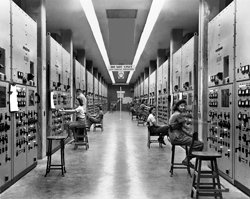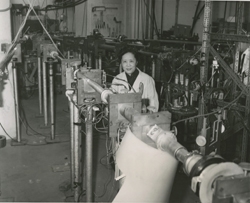By Brian Schwartz, Chair-Elect, APS Forum on the History of Physics (FHP)
The APS Forum on the History of Physics has arranged three invited sessions for the March 2014 meeting in Denver.
The title of the three sessions are B38- Women and the Manhattan Project; L38- The History of the Communication of Science to the Public and W38- Twentieth-Century Chinese Physicists and Physics.

Session B38: Invited Session: Women and the Manhattan Project
This session features 5 women speakers each with a different perspective on the role of women in the Manhattan Project.
Denise Kiernan, an author recently had her book The Girls of Atomic City: The Untold Story of the Women Who Helped Win World War II published. The book presents the true story of young women during World War II who worked in the secret city, Oak Ridge, Tennessee dedicated to making Uranium fuel for the atomic bomb dropped on Hiroshima.
Michele Gerber, a historian, wrote the book On the Home Front which is a comprehensive history of the Hanford Nuclear Site, in Washington State. Her presentation Women and the Hanford Site will illuminate the lives of these women at Hanford during the Manhattan Project, Their feelings about the work 50 years later will also be discussed. The Hanford site produced most of the plutonium used for the Alamogordo atomic bomb test and the bomb dropped on Nagasaki.
Ruth Howes, a physicist and author, will discuss her research on After the War: Stories of The Women Who Did Scientific and Technical Work on the Manhattan Project. Doors that had been open to women scientists and technicians abruptly closed as the economy returned to a peacetime footing. Ruth presents the stories of the women scientists and technicians of the Manhattan Project and their remarkable determination to continue their careers.
Cindy Kelly is the founder and Director on the Atomic Heritage Foundation, a non-profit organization in Washington, DC, dedicated to the preservation and interpretation of the Manhattan Project and the Atomic Age and its legacy. Her presentation, Preserving the Manhattan Project will focus on the progress made over the last 20 years to preserve the Manhattan Project properties that for decades have been threatened with demolition and indifference.
The final speaker is Olivia Fermi, granddaughter of Enrico Fermi on the topic Then and Now: Women Respond to the Manhattan Project -- An Illustrated Talk. Her talk discusses two women inextricably involved with and affected by the Manhattan Project, her grandmother Laura Fermi and Marian Naranjo who lives on the Santa Clara Pueblo near Los Alamos and Naranjo’s environmental and social justice activism.

Session L38: Invited Session: The History of the Communication of Science to the Public
This session features 5 speakers who are knowledgeable and currently play a significant role in the communication of science to the public.
Frank Burnet is Emeritus Professor of Science Communication, University of the West of England and will speak on The Establishment of Science Communication for the Public at the Royal Institution. The Royal Institution was founded in 1799 and one of its missions was “…for teaching …courses of philosophical lectures and experiments, the application of science to the common purposes of life.” Two of the greatest scientists of their time Humphry Davy and Michael Faraday played a key role in the Royal Institution’s outreach to the public.
Karen Rader is a historian of science at Virginia Commonwealth University. She is the co-author the book Life on Display: Revolutionizing U.S. Museums of Natural History and Science in the Twentieth Century. Her talk details The Exhibits Revolution in Science and Natural History Museums, 1900-1990 and shows that by the end of the twentieth century, American natural history and science museums had become institutions defined largely by their displays.
Susan Marie Frontczak is a writer, actor and storyteller who will speak on The Role of Living History in the Communication of Science to the Public. Susan acts the role of famous and accomplished women before diverse audience. Her storytale entitled Manya - The Living History of Marie Curie portrays Marie Curie’s radium and radioactivity discoveries and her difficulties as a woman at the turn of the 20th century.
Dennis Overbye is a science reporter for The New York Times will disccuss the The Historical Role of the New York Times in the Communication of Science to the Public. The New York Times more than any United States paper has and continued to play a major role in science reporting. It remains perhaps the only US newspaper with a significant science reporting staff and a weekly section, Science Tuesday, devoted to science and medicine.
Joseph Hanson is associated with PBS Digital Studios, will discuss The Future of the New Media in the Communication of Science. In his talk he will apply lessons learned from the near and distant history of science communication to put today's new media evolution into perspective. He will present clues as to where social media, digital journalism, open access, and on-line education will lead science communication in years to come.

Session W38: Invited Session: Twentieth-Century Chinese Physicists and Physics
In this session 5 speakers will discuss different aspects of the history of Twentieth-century Chinese physicists and physics. With the emergence of China as a first-tier nation in science, it is important for physicists and historians to familiarize themselves with the considerable past and accomplishments of Chinese science and scientists in the 20th century.
Yuelin Zhu recently received his PhD in the history of science from Harvard University and works at the Gutman Library. His talk Chien-Shiung Wu: An Icon of Physicist and Woman Scientist in China traces her life and physics career. Madame Wu was the daughter of a revolutionary father, and an activist in college in patriotic student movements. She was trained at UC Berkeley with E. O. Lawrence as her advisor. At Columbia University, Wu conceived and initiated the experiment on Cobalt-60, which, together with other two experiments, eventually proved the asymmetry of parity in weak-interactions. She was elected the first female president of the APS.
Xiaodong Yin was a physicist turned historian earning her Ph.D. at the Institute for the History of Natural Science in the Chinese Academy of Sciences. She is currently at the Capital Normal University, Beijing and will speak on Chinese Physicists Educated in the Great Britain during the First Half of the 20th Century. In her talk she details the more than 30 Chinese students who went to Great Britain to study physics and compares them with those who studied in Japan and America.
Tian Yu Cao is a Professor of Philosophy at Boston University. His talk Mao and Physics Research in China in the 1950s-1960s: The H-bomb Project and the Straton Model. The People's Republic of China detonated its first H-Bomb (with a yield of 3.3 Megatons using a Jiaxian Deng design) in June 1967, a mere 32 months after detonating its first fission weapon (the shortest fission-to-fusion development in history).
Bing Liu of Tsinghua University will speak on Some Problems in the Competition of High-temperature Superconductivity Research during the Late 1980s. He investigates the competition in high-temperature superconductivity among American, Japanese and Chinese scientists and the “Mathew Effect” (or accumulated advantage), the phenomenon where "the rich get richer and the poor get poorer”.
Lin Jinyan is in the Department of History of Science and Technology of the Institute for the History of Natural Science, Chinese Academy of Sciences. She will speak on A Brief History of the Institute of Theoretical Physics in the Chinese Academy of Sciences. Since 1978. Her talk will summarize the scientific activities and achievements of the Institute for Theoretical Physics (ITP) founded in 1978. She will compare ITP with university physics departments and explore its unique characteristics (both its strengths and weaknesses).
Finally, there will also be a staged reading of the science-based play W=S: Transistor Shock on Wednesday night, March 5th at 8pm.
